Ancient Greece–Ancient India relations
For the Ancient Greeks, “India" (Greek: Ινδία) meant only the upper Indus untill the time of Alexander the Great. Afterwards, “India" meant most of the northern half of the Indian subcontinent (including present-day India and Pakistan) to the Greeks. The Greeks referred to the Indians as "Indói" (Greek: Ἰνδοί), literally meaning "the people of the Indus River". Indians called the Greeks Yonas and “Yavanas”[1] from Ionians.[2]
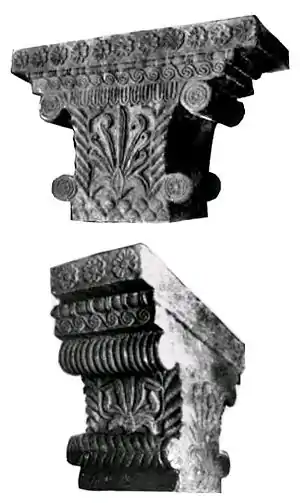
Mythology and legends
Dionysus
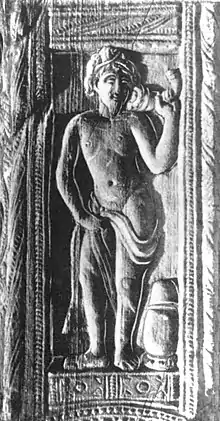
Megasthenes wrote about the prehistoric arrival of the God Dionysus in India.
According to Philostratus, god Dionysus was called Nysian or Nysean (Νύσιος) by the Indians.[3] Most probably, because according to legend he founded the city of Nysa in India.[4] When Alexander the Great arrived at the city, representatives of the city met him and told him not to capture the city and the land because the god had founded the city and named it Nysa after his nurse and also he named the mountain near the city, Meron (Μηρὸν) (i.e. thigh), because he grew in the thigh of Zeus.[5][6][7] More about the city below at the "Cities and places" section.
Apollonius Rhodius in Argonautica wrote about the Nysean, son of Zeus, who had left the tribes of the Indians and came to dwell at Thebes.[8]
In addition, Philostratus mention that at Delphi there was a disk of silver as an offering bearing the inscription: "Dionysus the son of Semele and of Zeus, from the men of India to the Apollo of Delphi" (ΔΙΟΝΥΣΟΣ Ο ΣΕΜΕΛΗΣ ΚΑΙ ΔΙΟΣ ΑΠΟ ΙΝΔΩΝ ΑΠΟΛΛΩΝΙ ΔΕΛΦΩΙ).[9] Furthermore, he mention that Indians who dwell in the Caucasus and along the river Cophen said that Dionysus was an Assyrian visitor when he came to them, who knew the religious rites of the Theban (according to some Greek myths god Dionysus was born in Thebes) while Indians who inhabit the district between the Indus and the Hydraotes and the continental region beyond, which ends at the river Ganges, declare that Dionysus was son of the river Indus, and that the Dionysus of Thebes was his disciple.[9]
The epic poem Dionysiaca by Nonnus, talked about the god Dionysus’ expedition to India. He also wrote about the Colletes (Ancient Greek: Κολλήτης) who was huge, immense and formidable and his ancestor was the founder of the Indian race.[10] In addition, in book 14 Hera transformed into an Indian in order to talk and persuade the Indian chief to fight the Dionysus army.[11]
Apollodorus in Bibliotheca wrote about Dionysus and the Indians.[12]
Polyaenus wrote that after Dionysus had subdued the Indians, he formed an alliance with them and the Amazons, and took them into his service. He later used them in his campaign against the Bactria.[13]
Herakles
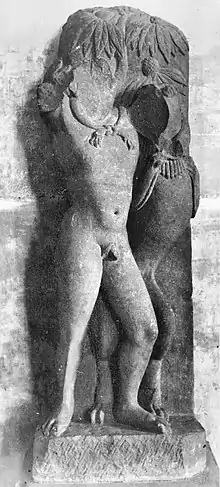
Megasthenes wrote about the prehistoric arrival of Herakles (Megasthenes' Herakles) in India.
Pandaie (Ancient Greek: Πανδαίη), was a daughter of Heracles whom he fathered in India. He gave her the southern part of India which is by the sea and she was a queen there.[14]
Others
Ganges was personified by the Greeks as a river god. Limaee was the Naiad-nymph of a lake in India and daughter of the river Ganges. She had a son named Athis.[15]
Hydaspes was personified by the Greeks as a river god (Hydaspes (mythology)). He supported the Indians in their war against the invading armies of the god Dionysus. He was the son of Thaumas and Elektra, and brother of the Iris. In addition, the king of the Indians Deriades (Δηριάδης) was the son of Hydaspes and Astris, who was a daughter of the god Helios.[16]
In Greek Anthology, Philodemus wrote that Perseus was in love with the Indian Andromeda.[17]
Apollodorus in Bibliotheca wrote that Medus conquered many barbarians and called the whole country under him Media. But when he was marching against the Indians he died.[18]
Dictys Cretensis, author of a pseudo-chronicle of the Trojan War, wrote that "Memnon, the son of Tithonus and Aurora, arrived with a large army of Indians and Ethiopians; a truly remarkable army which consisted of thousands and thousands of men with various kinds of arms, and surpassed the hopes and prayers even of Priam."[19]
Ancient Greek writers have written about Manticore, a monstrous creature which lived in India.[20][21][22]
Greek writers wrote that there were Cynocephaly (dog-headed) tribes in India.[23][24] Aulus Gellius in Attic Nights mentioned that some writers wrote also about a tribe in farthest India with bodies that are rough and covered with feathers like birds, who eat no food but live by inhaling the perfume of flowers.[25]
Eratosthenes said that the Macedonians, seeing a cavern in the land of the Parapamisadians, and hearing a certain legend which was current among the natives, or themselves forming a conjecture, spread the report that this forsooth was the cave where Prometheus had been bound.[26]
According to the Latin Letter from Alexander the Great to Aristotle[lower-alpha 1] a creature called Odontotyrannos attacked Alexander's men at their camp in India.
John Malalas has mixed the fictionalized work of the Pseudo-Callisthenes, Alexander Romance, with other materials and wrote about an affair of Alexander the Great with Kandake, adding that they got married. Malalas wrote that Kandake was an Indian queen and Alexander met her during his Indian campaign.[27][28][29]
Antigonus of Carystus,[30] Aristotle[31] and Ctesias wrote that there were Indian donkeys (ἰνδικὸς ὄνος) which were one-horned.[30] Animals similar to Unicorns.
Contact, records and influence between the two civilizations
Coinage and inscriptions
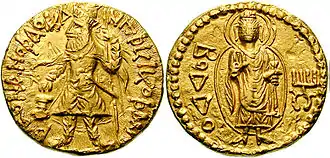
The Kushan Empire used the Greek alphabet and on their coins they used Greek legends. They also adopted other elements of the Greek culture of the Hellenistic Kingdoms. Art themes derived from Greek mythology were common initially but later Buddhist imagery dominated.[32]
The Nahapana, ruler of the Western Kshatrapas, established the Kshatrapa coinage, derived from Indo-Greek coinage. The obverse of the coins consists of the profile of the ruler with a legend in Greek while the reverse represents a thunderbolt and an arrow, within Brahmi and Kharoshthi legends.
The Rabatak inscription uses Greek script to write a language described as Arya. The inscription relates to the rule of the Kushan emperor Kanishka.
Art and literature
| Pompeii Lakshmi | |
|---|---|
 | |
| Material | Ivory |
| Height | 24.5 cm (9 1⁄2 in) |
| Discovered | c. 1930–1938 Pompeii |
| Present location | Secret Museum, Naples, Italy |
| Identification | 149425 |
In Sophocles' work, Antigone, Creon mentions the gold of India.[33]
The satirist Lucian wrote that Indians get drunk very easy with wine and they get worse than any Greek or Roman would be.[34]
In Greek Anthology, India and Indians are mentioned in many occasions.[35]
The Indian theater had adopted some elements of the Greek comedy.[36]
The Pompeii Lakshmi, an Indian sculpture of Lakshmi found in the ruins of Roman Pompeii.
Historians and geographers
Hecataeus of Miletus, wrote a survey of Asia and Africa in his Periígisis (Greek: Περιήγησις: to browse), now lost, which contained some information on India.[37]
Herodotus in his work Histories, includes important remarks on India.[37]
Ctesias in his work Indika (Greek: Ινδικά), records the beliefs and view of the Persians about India.
Ephorus wrote that the Indians inhabit a country in the east near sunrise.[38]
Xenophon in his work Cyropaedia mentioned India and the Indians.[39]
Aristobulus of Cassandreia wrote about the customs and the animals of India.[37]
Cleitarchus, probably did not travel to India, but his account of the country, based on Onesicritus’ and Nearchus’ reports, gained much popularity.[37]
Pseudo-Scymnus wrote in Circuit of the Earth that Indians occupy almost all the land toward the East.[40]
Eratosthenes attempted to calculate the exact size and shape of India, relying on reports written by travelers.[37]
Dionysius Periegetes described how Indians looked like.[41]
Arrian wrote about India in his work Indica (Greek: Ἰνδική).
Strabo described India in his work Geographica. He referred to India several times during the course of the book and he devoted book 15 to an extended description of the country.[37]
Stephanus of Byzantium wrote about geographical, mythological, and religious information about India.[42]
Ammianus Marcellinus in his work History wrote about India.[43]
Astronomy and astrology
Greek astronomical texts were translated into Sanskrit.[45] Yavaneśvara, translated the Yavanajataka, one of the earliest writings of Indian astrology, from Greek to Sanskrit. The zodiac signs introduced into India by the Greeks.[46]
Later, the Romaka Siddhanta is based on the astronomical learning of the Byzantine Empire.[47][48]
The Gargi Samhita states: "The Yavanas (Greeks) are barbarians, yet the science of astronomy originated with them and for this they must be honored".[49]
The Yuga Purana mentioned the Greeks.[1][50]
Philosophy and religion
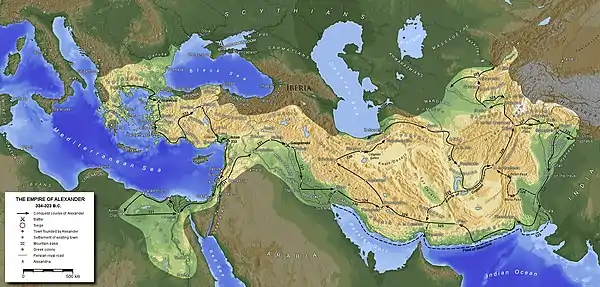
Pyrrhonism
The philosopher Pyrrho accompanied Alexander the Great on his Indian campaign, According to Diogenes Laërtius, Pyrrho developed his philosophy of Pyrrhonism in India when Pyrrho was there during the conquest of Alexander the Great. According to Christopher I. Beckwith's analysis, Pyrrho's philosophy was strikingly similar to the Buddhist three marks of existence,[51] indicating that Pyrrho's teaching is based on Buddhism.
Because of the high degree of similarity between Nāgārjuna's philosophy and Pyrrhonism, particularly the surviving works of Sextus Empiricus[52] Thomas McEvilley suspects that Nāgārjuna was influenced by Greek Pyrrhonist texts imported into India.[53]
Diogenes Laërtius wrote that Anaxarchus, Pyrrho's teacher, met and spoke with Indian gymnosophists and magi.[54]
Buddhism
Buddhism flourished under the Indo-Greeks, leading to the Greco-Buddhist cultural syncretism. The arts of the Indian sub-continent were also quite affected by Hellenistic art during and after these interactions. (Hellenistic influence on Indian art). The iconography of Vajrapani is clearly that of the hero Heracles, with varying degrees of hybridization.[55] Menander I was one of the patrons of Buddhism, he also was the subject of the Milinda Panha.
Dharmaraksita was a Greek who was converted to Buddhism. He was one of the missionaries sent by the Mauryan emperor Ashoka to proselytize Buddhism.
Mahadharmaraksita was a Greek Buddhist master, who according to Mahāvaṃsa traveled to Anuradhapura in Sri Lanka together with 30,000 Greek Buddhist monks from Alexandria of the Caucasus.[56] In addition, Mahāvaṃsa mention how early Buddhists from Sri Lanka went to Alexandria of the Caucasus to learn Buddhism.[56]
The Kandahar Greek Edicts of Ashoka, which are among the Ashoka's Major Rock Edicts of the Indian Emperor Ashoka were written in the Greek language. In addition, the Kandahar Bilingual Rock Inscription was written in Greek and Aramaic. Ashoka used the word "eusebeia" (piety) as a Greek translation for the central Buddhist and Hindu concept of "dharma" in the Kandahar Bilingual Rock Inscription.[57]
Ptolemy II Philadelphus is also mentioned in the Edicts of Ashoka as a recipient of the Buddhist proselytism of Ashoka:
Now it is conquest by Dhamma that Beloved-Servant-of-the-Gods considers to be the best conquest. And it [conquest by Dhamma] has been won here, on the borders, even six hundred yojanas away, where the Greek king Antiochos rules, beyond there where the four kings named Ptolemy, Antigonos, Magas and Alexander rule, likewise in the south among the Cholas, the Pandyas, and as far as Tamraparni. Rock Edict Nb13 (S. Dhammika)
Peripateticism
Aristotle’s knowledge of India came essentially from Scylax and Ctesias. He quoted Scylax to refer to Indian politics and mentions seven Indian animals, by clearly drawing on Ctesias.[37]
The Peripatetic philosopher Clearchus of Soli, traveled to the east to study Indian religions.[58]
The Peripatetic philosopher Theophrastus, in his book on history of plants contains an excursus on Indian species.[37] Also, in his work "On stones" describe rocks, stones and gems that are produced in India.[59]
The Peripatetic philosopher Aristocles of Messene (cited by the Christian polemicist Eusebius) said an Indian conversed with Socrates in Athens.[60]
And Aristoxenus the musician said that this argument comes from the Indians. For a man of that people met Socrates in Athens and asked him what his philosophy was about; and when he said that he was investigating human life, the Indian laughed at him, saying that no one could understand human affairs if he ignored the divine. Whether this is true, no one can say for sure.[61]
Christian
Clement of Alexandria wrote about India, Gymnosophists, Brahmans, Buddha, etc. in the Stromata.[62]
The Greek theologian Pantaenus was said to have traveled to India.
Sophism
The Greek Sophist Philostratus, in his work Life of Apollonius of Tyana (Greek: Βίος Απολλωνίου του Τυανέως), mentioned that the Greek philosopher Apollonius had traveled to India.
The Sophist Dio Chrysostom mentioned India in his work Discourses and wrote that Homer's poetry is sung in India.[63] He also mentioned that Bactrians and Indians were to be found in his audience in Alexandria (circa 100 CE).[64]
Others
The Sibylline Oracles mentioned India.[65]
The Cynic philosopher Onesicritus wrote about the gymnosophists, the people and the landscape of India.[37]
The Academic Skeptic philosopher Favorinus owned an Indian slave[66] named Autolekythos.[67]
Ptolemy, wrote about the Brahmanas (Greek: Βραχμάναι Μάγοι),[41] Narmada River and more.
The Neoplatonic philosopher Ammonius Saccas may have been of Shakyan Indian descent.
Varāhamihira, in a passage where he calls on the people to honour the Brahmans, said: “the Greeks, though impure, must be honoured, since they are trained in sciences, and therein excelled others. What, then are we to say of a Brahman, if he combines with his purity the height of science?”[68]
Scythianus traveled to India several times during the first century CE. He studied Indian philosophy there. He eventually settled in Alexandria Egypt and became a religious teacher. He wrote four books, which because the source of Manichaenism.
Political and military
At the Battle of Gaugamela, Darius used Indian troops against Alexander the Great. Later, Alexander's army fought the Indian army of King Porus at the Indian campaign of Alexander the Great. Plutarch wrote about the battle at his work Parallel Lives, "Life of Alexander". The Indian King Ambhi (Greeks called him Taxiles in their scripts) supported Alexander with his forces. Philostratus the Elder in the Life of Apollonius of Tyana wrote that in the army of Porus there was an elephant who fought brave against Alexander's army and Alexander dedicated it to the Helios (Sun) and named it "Ajax", because he thought that a so great animal deserved a great name. The elephant had gold rings around its tusks and an inscription was on them written in Greek: "Alexander the son of Zeus dedicates Ajax to the Helios" (ΑΛΕΞΑΝΔΡΟΣ Ο ΔΙΟΣ ΤΟΝ ΑΙΑΝΤΑ ΤΩΙ ΗΛΙΩΙ).[69] Alexander, also met and talked with Indian gymnosophists, including Dandamis and Kalanos.[70]
Alexander let the Taxiles and Porus to keep their kingdoms[71] and added Paropamisadae to the kingdom of Oxyartes.[72] In addition, he gave to Peithon[72][71] and Philip Indian satrapies.
Indo-Greek kingdoms were founded by the successor of Alexander the Great. (Greek conquests in India)
According to Indian sources, Greek troops seem to have assisted Chandragupta Maurya in toppling the Nanda Dynasty and founding the Mauryan Empire.[73]
Later, Seleucus I army encountered Chandragupta army. Chandragupta and Seleucus finally concluded an alliance. Seleucus gave him his daughter in marriage, ceded the territories of Arachosia, Herat, Kabul and Makran and he received 500 war elephants.
Bindusara, the second Mauryan emperor of India, had diplomatic relations and very friendly feelings towards the Greeks. He even asked from Antiochus I Soter to sent him a Greek sophist for his court.
Ptolemy II Philadelphus is recorded by Pliny the Elder as having sent an ambassador named Dionysius to the Mauryan court at Pataliputra in India,[74] probably to Emperor Ashoka:
- "But [India] has been treated of by several other Greek writers who resided at the courts of Indian kings, such, for instance, as Megasthenes, and by Dionysius, who was sent thither by Philadelphus, expressly for the purpose: all of whom have enlarged upon the power and vast resources of these nations." Pliny the Elder, "The Natural History", Chap. 21 [75]
Polybius wrote about the use of Indian elephants in battles and about the alliance between the Indian king Sophagasenus and Antiochus III the Great.[76]
Diodorus, quoting Iambulus, mentioned that the king of Pataliputra had a "great love for the Greeks".[77][78]
The Greek historian Apollodorus and the Roman historian Justin, affirmed that the Bactrian Greeks conquered India. Justin, also described Demetrius I as "King of the Indians". Greek and Indian sources indicate that the Greeks campaigned as far as Pataliputra until they were forced to retreat following a coup in Bactria in 170 BC.
The Heliodorus pillar is a stone column that was erected around 110 BCE in present-day central India in Vidisha, by Heliodorus (Greek: Ἡλιόδωρος), a Greek ambassador of the Indo-Greek king Antialcidas to the court of the Shunga king Bhagabhadra. The site is located about 5 miles from the Buddhist stupa of Sanchi.
The Roman Emperor Augustus received envoys from the Saka King. They gave him a letter which was written in Greek and asked for some diplomatic requests.[79][80][34]
The King Phraotes received a Greek education at the court of his father and spoke Greek fluently.[81]
Tamil poems described the Greek soldiers who served as mercenaries for Indian kings as: "The valiant-eyed Yavanas, whose bodies were strong and of terrible aspect".[82]
Alfred Charles Auguste Foucher said that some of the troops of Mara in the Gandhara sculptures may represent Greek mercenaries.[83]
Trade
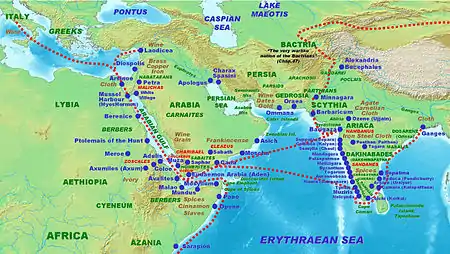
During the Roman and Byzantine period there were trade relations. (Indo-Roman trade relations)
The Isidore of Charax in his work The Parthian Stations (Ancient Greek: Σταθμοί Παρθικοί) described the trade route between the Levant and India in the 1st century BC.[84]
The so-called Muziris papyrus which is written in Greek, contains crucial information regarding the cargo of a ship named the Hermapollon that sailed back to Egypt from the Muziris in India.[85] Muziris is also mentioned in the Periplus of the Erythraean Sea as one of the Indian ports that Greek ships were sailing.[86]
Some of the Indian ports that Greek merchants were visiting where Muziris, Barygaza, Barbarikon, Minnagara, Ujjain and Ariaca.
The Periplus of the Erythraean Sea was a manual written in Greek for navigators who carried trade between Roman Empire and other regions, including ancient India. It gives detailed information about the ports, routes and commodities.
Procopius writes that, when Byzantines didn't want to purchase, any longer, their silk from the Persians, due to their conflicts, some monks coming from India, who had also spent a long time in a country called Serinda (Ancient Greek: Σηρίνδα) and was beyond India, talked with the Emperor Justinian and promised to settle the silk question and the Byzantines would not need to buy again the silk from the Persians.[87]
Chanakya mentioned Greeks and their polities in his Arthashastra.
Travelers and explorers
The Greek explorer Scylax, in about 515 BC, was sent by King Darius I of Persia to follow the course of the Indus River and discover where it led.
Nearchus, described India and the people living there.[37]
The Greek ethnographer and explorer of the Hellenistic period, Megasthenes was the ambassador of Seleucus I at India. In his work, Indika (Greek: Ινδικά), he wrote the history of Indians and their culture. Megasthenes also mentioned the prehistoric arrival of God Dionysus and Herakles (Megasthenes' Herakles) in India.
The successor of Megasthenes, Deimachus, also wrote about India.[37]
Zarmanochegas, met Nicholas of Damascus in Antioch and later he also traveled to Athens where he burnt himself to death.[88][89] Plutarch wrote that at Athens his "Indian tomb" was still there to his days.[90]
Eudoxus of Cyzicus and Hippalus traveled to Indian with their ships.
The Suda, a 10th Century Byzantine encyclopedia mentioned that when Theophilos the Indian returned from India he spent time in Antioch and the Emperor Constantius II treated him with all honor and respect.[91]
Sozomen, wrote that Meropius (Μερόπιός), a philosopher of Tyre, traveled together with two of his relatives, Frumentius (Φρουμέντιός) and Edesius (Ἐδέσιος) to India.[92][93]
The Christian Topography by Cosmas Indicopleustes was an essay in scientific geography written in Greek with illustrations and maps. The work mentioned India and the writer Cosmas Indicopleustes had actually made the journey and he described and sketched some of what he saw in his Topography. Indicopleustes means "Cosmas who sailed to India".
Cities and places
According to legend the god Dionysus founded the city of Nysa and named it Nysa and the land Nysaea (Νυσαία) after his nurse and he named the mountain near the city, Meron (Μηρὸν) (i.e. thigh), because he grew in the thigh of Zeus.[5][6] When Alexander arrived at the city, together with his Companion cavalry went to the mountain and they made ivy garlands and crowned themselves with them, as they were, singing hymns in honor of Dionysus. Alexander also offered sacrifices to Dionysus, and feasted in company with his companions.[6]
Alexander the Great ordered the Philip (son of Machatas) to built the Alexandria on the Indus.
Pliny the Elder wrote that Nearchus founded the town of Arbis during his voyage to India.[94]
At the Anuradhapura Kingdom in Sri Lanka, there was a Greek settlement. Professor Merlin Peris, former Professor of Classics at the University of Peradeniya, wrote that “The Greeks whom King Pandukabhaya settled in the West Gate of Anuradhapura were not second or third generation of Greeks who arrived in northwest India but were men who, just two decades ago at the most, left Greek homelands as Alexander’s camp followers and come to Sri Lanka with or in the wake of Alexander’s troops. When their fellow Greeks showed reluctance to push further south, these Greeks apparently had done so.”[95] Greeks called Sri Lanka as Taprobana. Stephanus of Byzantium writes that a metropolis of the Taprobana was called Argyra (Ancient Greek: Ἀργυρᾶ).[96] and that also there was a river which was called Phasis (Ancient Greek: Φᾶσις).[97]
The city of Sirkap was founded by Demetrius I of Bactria.
Panchaia was an island paradise located in the Indian Ocean mentioned by Greek writers.
Claudius Aelianus wrote that there were Macedonians who settled in India in the cities founded by Alexander.[98]
Stephanus of Byzantium wrote about a city called Daedala or Daidala (Ancient Greek: Δαίδαλα) in India,[99] which he called it Indo-Cretan city, most probably because it was a settlement of Cretan mercenaries.[100]
In addition, to the aforementioned cities, Stephanus of Byzantium also described many other Indian cities and places.
Other
Pāṇini, an ancient Sanskrit grammarian, was acquainted with the word yavana (Greek) in his composition.
Kātyāyana was a Sanskrit grammarian, mathematician and Vedic priest who lived in ancient India. He explained the term yavanānī as the script of the Yavanas. He took the same line as Pāṇini that the Old Persian term yauna became Sanskrtised to name all Greeks.
Theodectes, thought that the dark color of some Indians were because of the sun.[41]
Athenaeus in his Deipnosophistae mention about a Basilis (Βάσιλις) who wrote a series of books about the History of India.[101]
Claudius Aelianus wrote about the animals in India.[102] He also mentioned that there were Macedonians who settled in India in the cities founded by Alexander.[98]
The Unani System of Medicine, which is a traditional system of medicine practiced in India, refers to Graeco-Arabic medicine, which is based on the teachings of Greek physicians Hippocrates and Galen. The ancient Greek medical system enriched with local elements encountered a large response to the Indian people and to the physicians.[103]
Modern archaeological evidence
Bronze Age paintings in a building at Akrotiri (Akrotiri was a Minoan settlement), depicted monkeys. Most of the monkeys have been identified as Egyptian species. But there was a species that was harder to identify. Archaeologists teamed up with primatologists in order to re-examine the monkey paintings. The team has identified the monkey as a grey langur. Grey langurs live in southern Asia in what is now Nepal, Bhutan and India, particularly in the Indus Valley. Researcher say that Mesopotamia may have functioned as an intermediary that enabled the movement of goods, raw materials, people, and iconography between the east and west. Mesopotamia may have even afforded an opportunity for Aegean peoples to encounter the creatures themselves, first-hand.[104][105][106]
See also
Greco-Buddhism
Trade and relations
References
- The Influence of Greek Classics on Indian Culture in Ancient Era
- YAVANAS IN THE ANCIENT INDIAN INSCRIPTIONS
- Philostratus, Life of Apollonius of Tyana, 2.2
- St. Jerome, Chronicon, B1329
- Arrian, Anabasis of Alexander, 5.1
- Arrian, Anabasis of Alexander, 5.2
- Pliny the Elder, Natural History, 6.23.5
- Apollonius Rhodius, Argonautica, 2.904-906
- Philostratus, Life of Apollonius of Tyana, 2.9
- Nonnus, Dionysiaca, 36.196
- Nonnus, Dionysiaca, 14.303-14.317
- Apollodorus, Library, 3.5.1-2
- Polyaenus, Strategems, § 1.1.3
- Polyaenus, Strategems, 1.3.4
- Ovid, Metamorphoses 5. 47
- Nonnus, Dionysiaca, 26.351
- Greek Anthology, Book 5, 5.132
- Apollodorus, Library, 1.9.28
- Dictys Cretensis, Trojan War Chronicle, 4.4
- Aelian, Characteristics of Animals, 4.21 - GR
- Aelian, Characteristics of Animals, 4.21
- Pausanias, Description of Greece, 9.21.4
- Ctesias, Indica §§ 37, 40–3
- Megasthenes, Indica, vis-a-vis Pliny the Elder, Historia Naturalis 7.2: 14–22; Fragments XXX. B. Solin. 52. 26–30.
- Aulus Gellius, Attic Nights, §9.4
- Arrian, Anabasis of Alexander, 5.3
- Malalas, Chronography, §8.194-195
- Nawotka, Krzysztof; Wojciechowska, Agnieszka (October 2018). The Alexander Romance: History and Literature. Barkhuis. p. 226. ISBN 978-9492444714.
- Moore, Kenneth Royce (June 2018). Brill's Companion to the Reception of Alexander the Great. BRILL. p. 464. ISBN 978-9004285071.
- Antigonus, Compilation of Marvellous Accounts, 66
- Aristotle, History of Animals 2.1
- Kushan Empire (ca. Second Century B.C.–Third Century A.D.)-The Metropolitan Museum of Art
- Sophocles, Antigone, 1039-1040
- McLaughlin, Raoul (July 2010). Rome and the Distant East: Trade Routes to the ancient lands of Arabia, India and China. Continuum. ISBN 978-1847252357.
- Greek Anthology
- Daniélou, Alain (11 February 2003). A Brief History of India. ISBN 9781594777943.
- Strabo and India
- Cosmas Indicopleustes, Christian Topography, 148
- Xenophon, Cyropaedia
- Pseudo Scymnus or Pausanias of Damascus, Circuit of the Earth, 170-171
- GREEK IMAGE OF THE INDIAN SOCIETY
- Stephanus of Byzantium, Ethnica
- Ammianus Marcellinus, History
- JORDANES, GETICA, §I
- Pingree, David (1976). "The Recovery of Early Greek Astronomy from India". Journal for the History of Astronomy. Journal for the History of Astronomy, Vol. 7. 7 (2): 109. Bibcode:1976JHA.....7..109P. doi:10.1177/002182867600700202.
- Pingree, David (1976). "The Recovery of Early Greek Astronomy from India". Journal for the History of Astronomy. Journal for the History of Astronomy, Vol. 7. 7 (2): 112. Bibcode:1976JHA.....7..109P. doi:10.1177/002182867600700202.
- Sarma, (2000), p. 158
- McEvilley, (2001), p385
- Tandle, Sanjeevkumar (July 2014). INDIAN HISTORY. Ashok Yakkaldevi. p. 138. ISBN 9781312372115.
- Woodthorpe Tarn, William (June 2010). The Greeks in Bactria and India. Cambridge University Press. p. 452. ISBN 978-1108009416.
- Beckwith, Christopher I. (2015). Greek Buddha: Pyrrho's Encounter with Early Buddhism in Central Asia (PDF). Princeton University Press. p. 28. ISBN 9781400866328.
- Adrian Kuzminski, Pyrrhonism: How the Ancient Greeks Reinvented Buddhism 2008
- Thomas McEvilley, The Shape of Ancient Thought 2002 pp499-505
- Diogenes Laertius, Lives of the Philosophers, 9.61
- Herakles/Vajrapani, the companion of Buddha
- Greco-Buddhism: The Unknown Influence of the Greeks
- Hacker, Paul. Dharma in Hinduism, Journal of Indian Philosophy, 2006, 34:479-496
- The Interactions of Greek and non-Greek Populations in Bactria-Sogdiana during the Hellenistic Period, The University Of British Columbia, 1997, p. 32-33
- Theophrastus, On Stones, 36
- The Book of Eusebius #4, p.343
- Aristocles, Fragment 1.8-9, tr. Chiesara 2001, 11, cited in MONTE RANSOME JOHNSON & BRETT SHULTS EARLY PYRRHONISM AS A SECT OF BUDDHISM? A CASE STUDY IN THE METHODOLOGY OF COMPARATIVE PHILOSOPHY Comparative Philosophy Volume 9, No. 2 (2018) p 16 https://scholarworks.sjsu.edu/cgi/viewcontent.cgi?article=1246&context=comparativephilosophy
- Clement of Alexandria, The Stromata, or Miscellanies
- Dio Chrysostom, Discourses, The Fifty-third Discourse: On Homer
- "I behold among you, not merely Greeks and Italians and people from neighbouring Syria, Libya, Cilicia, nor yet Ethiopians and Arabs from more distant regions, but even Bactrians and Scythians and Persians and a few Indians...." Dio Chrysostom, Discourses 32.40 https://penelope.uchicago.edu/Thayer/E/Roman/Texts/Dio_Chrysostom/Discourses/32*.html
- Sibylline Oracles
- https://www.academia.edu/8957440/_Making_Space_for_Bicultural_Identity_Herodes_Atticus_Commemorates_Regilla_in_T._Whitmarsh_ed._Local_Knowledge_and_Microidentities_in_the_Imperial_Greek_World._Cambridge_University_Press_2010_125-162
- Philostratus Lives of the Sophists 490
- Mishra, Mohan (March 2012). India Through Alien Eyes. BalboaPressAU. p. 54. ISBN 978-1452504513.
- Philostratus the Elder, Life of Apollonius of Tyana, § 2.12
- Plutarch, Life of Alexander, §8
- Diodorus Siculus, Library 18.3.1
- Diodorus Siculus, Library 18.39.1
- Kumar, Praveen (November 2017). Complete Indian History for IAS Exam: Highly Recommended for IAS, PCS and other Competitive Exam. Educreation Publishin. p. 81.
- Mookerji, Radha Kumud (1988) [First published 1966]. Chandragupta Maurya and his times (4th ed.). Motilal Banarsidass. p. 38. ISBN 81-208-0433-3.
- Pliny the Elder, "The Natural History", Chap. 21 Archived 2013-07-28 at the Wayback Machine
- Polybius, Histories
- The historian Diodorus wrote that the king of Pataliputra, apparently a Mauryan king, "loved the Greeks": "Iambulus, having found his way to a certain village, was then brought by the natives into the presence of the king of Palibothra, a city which was distant a journey of many days from the sea. And since the king loved the Greeks ("Philhellenos") and devoted to learning he considered Iambulus worthy of cordial welcome; and at length, upon receiving a permission of safe-conduct, he passed over first of all into Persia and later arrived safe in Greece" Diodorus ii,60.
- "Diodorus testifies to the great love of the king of Palibothra, apparently a Mauryan king, for the Greeks" Narain, "The Indo-Greeks", p. 362.
- McLaughlin, Raoul (November 2016). The Roman Empire and the Silk Routes: The Ancient World Economy & the Empires of Parthia, Central Asia & Han China. Pen & Sword History. ISBN 978-1473833746.
- McLaughlin, Raoul (September 2014). The Roman Empire and the Indian Ocean: The Ancient World Economy and the Kingdoms of Africa, Arabia and India. Pen and Sword Military. ISBN 978-1526738073.
- (Life of Apollonius Tyana, II 31)
- Pande, L.V.; Varadpande, M.L. (1987). History of Indian Theatre. 1. Abhinav Publications. p. 235. ISBN 9788170172215. Retrieved 2014-12-13.
- William Woodthorpe Tarn (2010). The Greeks in Bactria and India. Cambridge University Press. p. 250. ISBN 978-1108009416.
- Parthian Stations. By Isidore of Charax.
- THE MUZIRIS PAPYRUS AND THE CYCLES OF SOUTH INDIAN PEPPER TRADE
- Periplus of the Erythraean Sea, 54
- Procopius, History of the Wars, 8.17
- Strabo, xv, 1, on the immolation of the Sramana in Athens (Paragraph 73).
- Dio Cassius, liv, 9.
- Plutarch, Life of Alexander
- Suda Encyclopedia, theta 197
- Sozomenos, Ecclesiastical History, 2.24
- Sozomenos, Ecclesiastical History - GR
- Pliny the Elder, Natural History, §6.26.1
- Did Anuradhapura Greeks come east with Alexander?
- Stephanus of Byzantium, Ethnica, §A115.1
- Stephanus of Byzantium, Ethnica, § Ph660.2
- Aelian, Characteristics of Animals, § 16.3
- Stephanus of Byzantium, Ethnica, D216.8
- Woodthorpe Tarn, William (June 2010). The Greeks in Bactria and India. Cambridge University Press. p. 250. ISBN 978-1108009416.
- Athenaeus, Deipnosophists, 9.390
- Aelian, Characteristics of Animals
- Poulakou-Rebelakou, E; Karamanou, M; George, A (2015). "The impact of ancient Greek medicine in India: the birth of Unani medicine". Acta Med Hist Adriat. 13 (2): 323–8. PMID 27604201.
- A new identification of the monkeys depicted in a Bronze Age wall painting from Akrotiri, Thera
- Ancient monkey painting suggests Bronze Age Greeks travelled widely
- How we solved the Greek monkey mystery – and found an important clue to Bronze Age world
Notes
- Latin: Epistola Alexandri ad Aristotelem